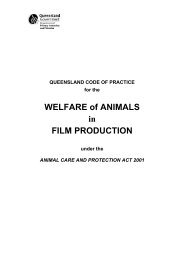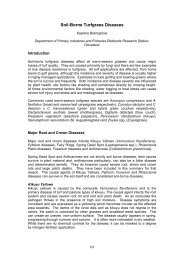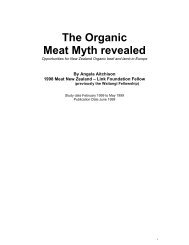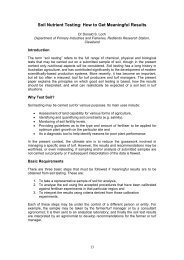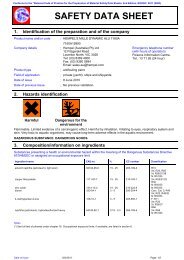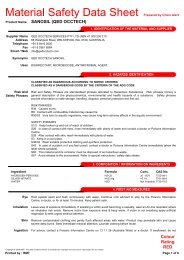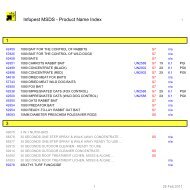AGCP Paraquat-Diquat 250 Herbicide - MSDS
AGCP Paraquat-Diquat 250 Herbicide - MSDS
AGCP Paraquat-Diquat 250 Herbicide - MSDS
Create successful ePaper yourself
Turn your PDF publications into a flip-book with our unique Google optimized e-Paper software.
MATERIAL SAFETY DATA SHEET<br />
<strong>AGCP</strong> <strong>Paraquat</strong>-<strong>Diquat</strong> <strong>250</strong> <strong>Herbicide</strong><br />
1. IDENTIFICATION OF THE CHEMICAL PRODUCT AND COMPANY<br />
Supplier: Australia Generic Crop Protection Pty Ltd<br />
ACN: 136 756 146<br />
Street Address: 7 Folkestone Road, Glen Waverley Vic 3150<br />
Telephone: (03) 9887 7025<br />
Facsimile: (03) 9887 7578<br />
Emergency telephone number: National Poisons Information Centre: Dial 13 11 26.<br />
Product name: <strong>AGCP</strong> <strong>Paraquat</strong>-<strong>Diquat</strong> <strong>250</strong> <strong>Herbicide</strong><br />
Product Type Group C <strong>Herbicide</strong><br />
Product Use: For the control of a wide range of grasses and broadleaf weeds. Can be<br />
utilised in crop establishment programs.<br />
2. HAZARDS IDENTIFICATION<br />
Hazard classification:<br />
Based on available information, classified as toxic according to health criteria of NOHSC Australia.<br />
UN number: 3016<br />
Dangerous goods class: 6.1 (toxic)<br />
Subsidiary risk: none<br />
Chemical type: bipyridilium<br />
Hazchem code: 2X<br />
Poisons schedule: 7<br />
Packing group: III<br />
EPG/IERG: 6B5<br />
3. COMPOSITION/INFORMATION ON INGREDIENTS<br />
Formulation Type: Aqueous Concentrate<br />
Chemical Entity CAS No Conc.<br />
<strong>Paraquat</strong> (present as paraquat dichloride) 1910-42-5 11.5% (135 g/L)<br />
<strong>Diquat</strong> (present as diquat dibromide) 85-00-7 9.8% (115 g/L)<br />
Water 7732-18-5 30 – 60%<br />
Emulsifiers 10 – 29%<br />
Other ingredients determined not to be hazardous < 1%<br />
This is a commercial product whose exact ratio of components may vary.<br />
4. FIRST AID MEASURES<br />
OBTAIN IMMEDIATE MEDICAL ATTENTION. SPEED IS ESSENTIAL.<br />
Swallowed: If poisoning occurs get to a doctor or hospital quickly, warning by telephone of the<br />
estimated arrival time so that treatment is not delayed. If more than 15 minutes from a<br />
hospital induce vomiting, if this has not already occurred, by tickling back of throat with<br />
a clean, blunt instrument (e.g. spoon handle). DO NOT delay the start of treatment.<br />
Eye: Immediately irrigate with copious quantities of water for at least 20 minutes. Eyelids to<br />
be held open. Remove clothing if contaminated and wash skin. Urgently seek medical<br />
assistance. Transport to hospital or medical centre. If splashed with the concentrate,<br />
patients should be reviewed after 24 hours. Referral to an ophthalmologist should be<br />
considered.<br />
Skin: Immediately take off all contaminated clothing. Wash skin immediately with water<br />
followed by soap and water. If skin is broken, the component paraquat can be<br />
______________________________________________________________________________________________________<br />
Australia Generic Crop Protection Pty Ltd 1 of 6 Product: <strong>AGCP</strong> <strong>Paraquat</strong>-<strong>Diquat</strong> <strong>250</strong> <strong>Herbicide</strong><br />
ACN: 136 756 146 Issued: 29-Sep-2010
MATERIAL SAFETY DATA SHEET<br />
absorbed through the skin. Seek medical advice. Contaminated clothing should be<br />
laundered before reuse.<br />
Inhaled: Remove victim from exposure. Remove contaminated clothing and loosen remaining<br />
clothing. Allow patient to assume most comfortable position and keep warm. Seek<br />
medical advice.<br />
ADVICE TO DOCTOR<br />
Rapid treatment is essential. Refer to ‘<strong>Paraquat</strong> Poisoning. A Practical Guide to Diagnosis, First Aid<br />
and Hospital Treatment’ (2003 or later edition) – available at most major treatment hospitals and<br />
Poisons Information Centres.<br />
Treatment: Wash out stomach and test urine and gastric aspirate (if clear) for presence of paraquat.<br />
Give up to 1 litre of 15% aqueous suspension of Fuller’s Earth orally or via gastric tube, together with a<br />
suitable purgative (200mL of an aqueous solution of mannitol). Repeat administration of absorbent<br />
plus purgative until absorbent is seen in stools. This should normally take between 4 and 6 hours after<br />
the start of treatment.<br />
Do not use supplemental oxygen.<br />
With the possibility of late onset conjunctival ulceration it is advised that patients with paraquat eye<br />
injuries are reviewed the day after first presentation. At the review, consideration should be given to<br />
treating the eyes with a local antibiotic preparation to prevent secondary infection. Local treatment with<br />
a suitable steroid will aid resolution of granulation tissue. Corneal oedema, which may persist for up to<br />
3 – 4 weeks, may cause blurring of vision.<br />
5. FIRE-FIGHTING MEASURES<br />
Suitable extinguishing media: Use water fog (or if unavailable fine water spray), foam, dry agent,<br />
(carbon dioxide, dry chemical powder).<br />
Hazards from combustion products<br />
Not combustible, however, following evaporation of aqueous component residual material may burn.<br />
On burning will emit toxic fumes. Fire fighters must wear self contained breathing apparatus if there is<br />
risk of exposure to products of combustion.<br />
Precautions for Firefighters and Special Protective Equipment<br />
Firefighters to wear self-contained breathing apparatus if risk of exposure to vapour or products of<br />
combustion.<br />
6. ACCIDENTAL RELEASE MEASURES<br />
Emergency Procedure: Wash area down thoroughly with water or cover with absorbent (soil, sand,<br />
vermiculite). Collect and seal in properly labelled drums for disposal. Wash area down effected area<br />
with excess water. Spills are slippery.<br />
If contamination of sewers or waterways has occurred advise the local emergency services.<br />
7. HANDLING AND STORAGE<br />
For use by licensed pest-control operators or primary producers only (Victorian requirement). Store in<br />
the closed original container in a dry, cool, well-ventilated locked room or place away from children,<br />
animals, food, feedstuffs, seed and fertilisers. Do not store for prolonged periods in direct sunlight. Do<br />
not put into drink containers.<br />
This material is a Schedule 7 Poison and must be stored, maintained and used in accordance with the<br />
relevant regulations.<br />
8. EXPOSURE CONTROLS / PERSONAL PROTECTION<br />
National occupational exposure limits<br />
PRECAUTIONS FOR USE<br />
EXPOSURE STANDARDS<br />
There are no assigned values for this specific product; however, exposure standards for the active<br />
ingredients are as follows:<br />
TWA ppm mg/m3<br />
<strong>Paraquat</strong> (respirable sizes) 0.1<br />
<strong>Diquat</strong> 0.5<br />
Pyridine base 1 5 Can be absorbed by skin<br />
As published by the National Occupational Health and Safety Commission –<br />
______________________________________________________________________________________________________<br />
Australia Generic Crop Protection Pty Ltd 2 of 6 Product: <strong>AGCP</strong> <strong>Paraquat</strong>-<strong>Diquat</strong> <strong>250</strong> <strong>Herbicide</strong><br />
ACN: 136 756 146 Issued: 29-Sep-2010
MATERIAL SAFETY DATA SHEET<br />
TWA – the Time-Weighted Average airborne concentrations over an eight-hour working day, for a fiveday<br />
working week over an entire working life.<br />
STEL (Short Term Exposure Limit) – the average airborne concentration over a 15 minute period<br />
which should not be exceeded at any time during a normal eight-hour work day. According to current<br />
knowledge these concentrations should neither impair the health of nor cause undue discomfort to<br />
nearly all workers.<br />
These exposure standards are not applicable to field use.<br />
All atmospheric contamination should be kept to as low a level as is workable. Exposure Standards<br />
should not be used as fine dividing lines between safe and dangerous concentrations of chemicals.<br />
They are not a measure of relative toxicity.<br />
If the directions for use on the product label are followed, exposure of individuals using the product<br />
should not exceed the above standard. The standard was created for workers who are routinely,<br />
potentially exposed during manufacture of the product.<br />
Re-entry Period - Do not enter treated areas without protective clothing (waterproof footwear, clothing<br />
and gloves) until spray has dried.<br />
Engineering Controls<br />
In the workplace – ensure ventilation is adequate to maintain air concentrations of components below<br />
quoted Exposure Standards. Avoid generating and inhaling mists. Keep containers closed when not in<br />
use.<br />
Personal Protection<br />
Wear overalls, rubber boots, face shield, safety shoes, gloves (L), and apron.<br />
Manufacture, Packaging and Transport: Avoid skin and eye contact and the inhalation of vapour and<br />
mist. Wear overalls, face shield or goggles, elbow-length impervious gloves, splash apron and rubber<br />
boots. Always wash hands before smoking, eating, drinking or using the toilet. Wash contaminated<br />
clothing and other protective equipment before storing or re-using.<br />
If inhalation risk of vapour or spray exists wear organic vapour respirator meeting the requirements of<br />
AS/NZ 1715 and AS/NZ 1716.<br />
Preparation and Use of Product: Avoid contact with eyes, skin and clothing. When opening the<br />
container and preparing product for use wear cotton overalls buttoned to the neck and wrist, washable<br />
hat, elbow-length PVC gloves, face shield or goggles and half face-piece respirator or disposable<br />
respirator. Do not work in spray mist.<br />
When there is a risk of exposure to spray mist wear a face mask or respirator covering nose and<br />
mouth and capable of filtering spray droplets. A high efficiency type particulate respirator is<br />
recommended, but in any event use a respirator meeting the requirements of AS/NZS 1715 and<br />
AS/NZS 1716. After use and before eating, drinking or smoking, wash hands, arms and face<br />
thoroughly with soap and water. After each day’s use, wash contaminated clothing, gloves and face<br />
shield or goggles. Avoid contacting vegetation wet with spray, but if necessary to do so, wear<br />
waterproof footwear and waterproof protective clothing and gloves.<br />
9. PHYSICAL AND CHEMICAL PROPERTIES<br />
Appearance: dark green/blue liquid<br />
Flash Point: not applicable (aqueous)<br />
Odour: characteristic of pyridine base<br />
Flammability: non combustible<br />
Boiling/Melting point: 100°C approx.<br />
Combustibility: non combustible<br />
Vapour pressure: not available<br />
Solubility in water: soluble<br />
Specific gravity: 1.16 g/cm3 at 20°C<br />
Volatility: not volatile<br />
pH (1% aqueous): 5 – 6.5<br />
Corrosiveness: corrosive<br />
10. STABILITY AND REACTIVITY<br />
Stability: Avoid strong oxidising agents<br />
______________________________________________________________________________________________________<br />
Australia Generic Crop Protection Pty Ltd 3 of 6 Product: <strong>AGCP</strong> <strong>Paraquat</strong>-<strong>Diquat</strong> <strong>250</strong> <strong>Herbicide</strong><br />
ACN: 136 756 146 Issued: 29-Sep-2010
11. TOXICOLOGICAL INFORMATION<br />
MATERIAL SAFETY DATA SHEET<br />
ACUTE TOXICITY<br />
This product is toxic according to NOHSC Australia.<br />
Ingestion: HARMFUL<br />
Rapid treatment is essential. The immediate effects of poisoning depend on the dose of paraquat and<br />
diquat absorbed into the blood. Mild poisoning occurs at < 20 mg paraquat ion/kg body weight and the<br />
effects are vomiting and diarrhoea.<br />
Moderate to severe poisoning occurs at 20 – 30 mg paraquat ion/kg body weight and the effects are<br />
vomiting, abdominal discomfort, soreness and inflammation of the mouth, throat and oesophagus,<br />
difficulty in swallowing and, later, diarrhoea. Ulceration of lips, mouth, throat and intestine may follow<br />
within 24 – 48 hours. Kidney and liver damage may appear 1 – 3 days after exposure. Can cause<br />
death by a delayed proliferating fibrosis of the lung within 1 – 3 weeks. Lethal poisoning occurs at > 30<br />
mg paraquat ion/kg body weight and the effects are nausea and vomiting, and can cause death by<br />
multi-organ failure and circulatory collapse within 48 hours. The lethal dose of diquat dibromide for<br />
man is approximately 4 – 6 g of diquat (equivalent to approx. 60 mg/kg body weight).<br />
The following acute oral toxicity results have been determined for the active ingredients of the product:<br />
<strong>Paraquat</strong> dichloride: LD50 (rat) = 283 mg/kg (93.4 mg paraquat ion/kg)<br />
<strong>Diquat</strong> dibromide: LD50 (rat) = 1009 mg/kg, (214 mg diquat ion/kg)<br />
Skin contact: IRRITANT<br />
Contact with skin will result in irritation. The product is also a skin sensitiser. Can cause inflammation<br />
and in severe cases blistering of the skin. Contamination of the nails may cause white spots or in<br />
severe cases cracking and loss of the nail. Normal growth follows without delay. Intact skin is a very<br />
effective barrier to paraquat. Broken skin removes the barrier and paraquat may be absorbed with<br />
effects as outlined above under ‘Swallowed’. Repeated or prolonged skin contact may lead to allergic<br />
contact dermatitis.<br />
Modelling predicted for intact human skin and diluted solutions that systemic toxicity would be unlikely,<br />
but the risk increased significantly with damaged skin or concentrated solutions.<br />
The following acute dermal toxicity results have been determined for the active ingredients of the<br />
product:<br />
<strong>Paraquat</strong> dichloride: LD50 (rat) = > 2000 mg/kg (> 660 mg paraquat ion/kg)<br />
<strong>Diquat</strong> dibromide: LD50 (rat) = > 2000 mg/kg (> 424 mg diquat ion/kg)<br />
Eye contact: IRRITANT<br />
Eye irritation may be delayed. May lead to severe, painful irritation and ulceration of corneal and<br />
conjunctival epithelium which may give rise to secondary infection. Loss of corneal and conjunctival<br />
epithelium and even mild iritis can occur with the risk of secondary infection and consequent residual<br />
corneal scarring.<br />
Corneal oedema may persist for up to 3-4 weeks with temporary blurring of vision, permanent damage<br />
to eyes is a possibility.<br />
Inhalation: TOXIC<br />
Highly toxic if inhaled. However, unlikely to be hazardous by inhalation because of low vapour<br />
pressure of the material at ambient temperature. Nose bleeding and soreness of the throat may result<br />
from spray mist or dust trapped on the nasal mucosa. Irritating to the respiratory system. Pulmonary<br />
oedema may occur up to 48 hours after exposure and could prove fatal.<br />
This product contains a stenching agent to give an offensive smell. This has been done to reduce the<br />
likelihood of accidental ingestion. This stenching agent may cause headaches and nausea in some<br />
people when inhaled. The presence of this offensive smell in the air does not necessarily indicate the<br />
presence of paraquat.<br />
The following acute inhalation toxicity results have been determined for the paraquat dichloride:<br />
LC50 = 0.5 – 1.5 µg/L/4hrs<br />
CHRONIC TOXICITY<br />
Studies in animals have shown that repeated doses of paraquat do not produce carcinogenic nor<br />
teratogenic effects or adverse reproductive effects. The dietary no effect level in the rat was 25 ppm of<br />
paraquat over 2 years. Ingestion studies in animals have shown that repeated doses of diquat produce<br />
cataracts in test animals (dog, rat). These effects have not been seen in occupationally exposed<br />
humans.<br />
The ADI (Acceptable Daily Intake) for humans (paraquat ion) is 0.004 mg/kg/day.<br />
The ADI (Acceptable Daily Intake) for humans (diquat ion) is 0.002 mg/kg/day.<br />
______________________________________________________________________________________________________<br />
Australia Generic Crop Protection Pty Ltd 4 of 6 Product: <strong>AGCP</strong> <strong>Paraquat</strong>-<strong>Diquat</strong> <strong>250</strong> <strong>Herbicide</strong><br />
ACN: 136 756 146 Issued: 29-Sep-2010
12. ECOLOGICAL INFORMATION<br />
MATERIAL SAFETY DATA SHEET<br />
Ecological information: The active ingredients paraquat and diquat are toxic to aquatic organisms.<br />
96hr LC50 (rainbow trout): 55 mg/L (static) for paraquat and 21 mg/L for diquat. The 96 hr LC50<br />
(brown trout): 2.5 – 13 mg/L for paraquat and 96 hr LC50 (mirror carp): 67 mg/L for diquat. ErC50 72<br />
hours for green algae is 0.34 mg/L.<br />
<strong>Paraquat</strong> and diquat are both highly toxic to birds. The oral LD50 for hens is 262 – 380 mg/kg for<br />
paraquat and 200 – 400 mg/kg for diquat.<br />
Environmental fate: Distribution and persistence - paraquat and diquat are both rapidly absorbed and<br />
deactivated by soil. There is no mobility in soil or into ground water. There is evidence of photodegradation<br />
in water and plants.<br />
13. DISPOSAL CONSIDERATIONS<br />
SPILLS AND DISPOSAL<br />
In case of spillage it is important to take all steps necessary to:<br />
• Avoid eye and skin contact.<br />
• Avoid contamination of waterways and drains.<br />
Procedure for spill:<br />
(1) Keep all bystanders away.<br />
(2) Wear full length clothing and PVC gloves to prevent skin and eye contamination.<br />
(3) Re-position any leaking containers so as to minimise further leakage.<br />
(4) Dam and absorb spill with an absorbent material (e.g. sand or soil).<br />
(5) Shovel the absorbed spill into drums.<br />
(6) Disposal of the absorbed material will depend upon the extent of the spill.<br />
• For quantities up to 50L of product bury in a secure landfill site.<br />
• For quantities greater than 50L seek advice from the manufacturer (use emergency contact<br />
number below) before attempting disposal. Contain in a secure location until disposal method is<br />
established.<br />
(7) Decontaminate the spill area with detergent and water and rinse with the smallest volume of water<br />
practicable.<br />
(8) For large spills clear area of all unprotected personnel. Rapid decontamination of paraquat is<br />
essential. Crystalline material from dried concentrate may become suspended in air causing<br />
irritation and nose bleeds. Wear protective equipment to prevent skin and eye contamination and<br />
inhalation of mists and dust. If contamination of crops, sewers or waterways has occurred advise<br />
emergency services or State Department of Agriculture.<br />
(9) Remove and wash all protective clothing and equipment. Change contaminated clothing<br />
immediately. Launder as soon as possible. Shower, using liberal quantities of soap and water on<br />
completion of the mopping up operations.<br />
Dispose of empty, used containers by:<br />
(a) Triple rinsing or preferably pressure rinsing containers with water. Add the rinsings to the spray<br />
tank. DO NOT dispose of undiluted chemicals on site.<br />
(b) If recycling, replace cap and return clean containers to recycler or designated collection point.<br />
(c) If not recycling, break, crush or puncture and bury empty containers in a local authority landfill. If no<br />
landfill is available, bury the containers below 500 mm in a disposal pit specifically marked and set<br />
up for this purpose clear of waterways, desirable vegetation and tree roots. Empty containers and<br />
product should not be burnt.<br />
Returnable containers (110 L):<br />
(a) Empty contents fully into application equipment. Do not rinse.<br />
(b) Close all valves and return to designated collection point for re-use.<br />
14. TRANSPORT INFORMATION<br />
Transport Classification – Road and Rail:<br />
UN No.: 3016 Proper Shipping Name: BIPYRIDILIUM PESTICIDES LIQUID, TOXIC, N.O.S.<br />
Class: 6.1 (CONTAINS PARAQUAT AND DIQUAT)<br />
Packing Group: III Hazchem: 2X<br />
Segregation of Dangerous Goods: Not to be loaded with explosives (class 1), nitro-methane, food<br />
and food packaging in any quantity, however, exemptions may apply.<br />
______________________________________________________________________________________________________<br />
Australia Generic Crop Protection Pty Ltd 5 of 6 Product: <strong>AGCP</strong> <strong>Paraquat</strong>-<strong>Diquat</strong> <strong>250</strong> <strong>Herbicide</strong><br />
ACN: 136 756 146 Issued: 29-Sep-2010
15. REGULATORY INFORMATION<br />
MATERIAL SAFETY DATA SHEET<br />
Regulatory information:<br />
Hazard category: T Toxic<br />
Xi Irritant<br />
Risk phrases:<br />
R24/25 Toxic in contact with skin and if swallowed.<br />
R26 Very toxic by inhalation.<br />
R36/37/38 Irritating to eyes, respiratory system and skin.<br />
R43 May cause sensitization by skin contact.<br />
R48/25 Toxic: danger of serious damage to health by prolonged exposure if Swallowed.<br />
R50/53 Very toxic to aquatic organisms, may cause long-term adverse effects in the aquatic<br />
environment.<br />
Safety phrases:<br />
S1/2 Keep locked-up and out of the reach of children.<br />
S13 Keep away from food, drink and animal feeding stuffs.<br />
S20/21 When using, do not eat, drink or smoke.<br />
S23 Do not breathe spray.<br />
S35 This material and its container must be disposed of in a safe way.<br />
S36/37/39 Wear suitable protective clothing, gloves and eye/face protection<br />
S45 In case of accident of if you feel unwell, seek medical advice immediately (show label where<br />
possible).<br />
S57 Use appropriate containment to avoid environmental contamination.<br />
16. OTHER INFORMATION<br />
All information contained in this document is as accurate as possible based on information submitted<br />
by raw material suppliers. Australia Generic Crop Protection Pty Ltd will not be responsible for any<br />
damages that may result from reliance on the information contained herein.<br />
Contact: Australia Generic Crop Protection Pty Ltd<br />
7 Folkestone Road Phone 03 9887 7025<br />
Glen Waverley Vic 3150 Fax 03 9887 7578<br />
www.agcp.com.au email: sales@agcp.com.au<br />
______________________________________________________________________________________________________<br />
Australia Generic Crop Protection Pty Ltd 6 of 6 Product: <strong>AGCP</strong> <strong>Paraquat</strong>-<strong>Diquat</strong> <strong>250</strong> <strong>Herbicide</strong><br />
ACN: 136 756 146 Issued: 29-Sep-2010






